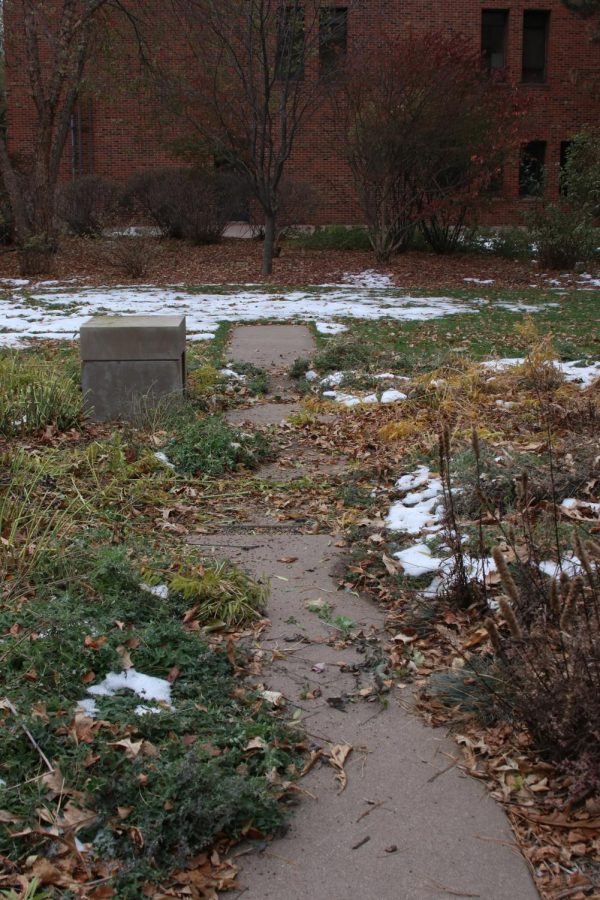Have no fear, landscaping is near
Hamline Facilities were thrown a wrench with the recent snow.
Lauren Thompson
Instead of mowing lawns or removing leaves, the landscaping crew on campus has needed to trim down plants and shrubs.
November 4, 2020
As if 2020 has not been crazy enough, recent weather has reflected yet another lack of normalcy in people’s lives. Hamline’s Facilities Services fall clean up efforts were halted due to the mid-October snowstorm that hit Oct. 20.
“In all the years I have been here — actually, in my whole career — I have never seen this kind of weather,” said Ken Dehkes, Director of Facilities Operations.
Before the approximate 8 inches of snow, Hamline was cleaning up leaves and perennial beds, all of which would be composted in preparation for the winter and spring ahead.
“At the moment, we are prepping for winter… so when summer comes again campus is staying looking nice,” said Freddy Alonso, junior and student worker for Facilities. “[The snow] was a little shocking but luckily we all know what we’re getting into.”
As for snow clearing, it is a joint responsibility. Facilities are responsible for sidewalks primarily, the custodial staff does the entryways of buildings and an outside contractor does the roads on campus as well as the parking lots. This distribution of jobs allows Facilities to best allocate resources and work efficiently.
Hamline has 11.4 miles of walkway space that is maintained for snow removal, 7.5 miles of that lineal sidewalk. Across campus, there are 880 steps that need to be shoveled, which accumulate to about 3/4 of an acre of handwork. This is close to the size of a football field.
“The idea is we are trying to get areas as opened and cleared as possible before people start work and classes,” Dehkes said. “Not just people living on campus, but commuters and the workforce coming onto campus.”
Generally, Facilities begin their day clearing snow at around 6:00 a.m., while larger and more demanding snowfalls would result in them beginning earlier. The outside contractor removing snow in parking lots and roads is scheduled anytime between midnight and 7:30 a.m.
As for the treatment of ice on campus, it is handled diligently and deliberately. The chloride treatments that are placed to loosen or “melt” ice can have harmful consequences when overused. One of the largest impacts it can have is on the environment, specifically the water.
All full-time staff go through training sponsored by MN pollution control agency regarding how to handle ice. This allows them to distribute salt, chloride and other products adequately and accurately. One teaspoon of salt contaminates five gallons of water, which would result in one of Facilities’ 50-pound bags of chloride contaminating 80 thousand gallons.
“There are many reasons we try to minimize the use. One of the big ones is the environmental impact on water, especially in our urban landscape,” Dehkes said. “Almost all the places with hard surfaces are draining into the stormwater and into the Mississippi River. In facilities, our goal is to be good stewards of Hamline’s physical assets [and we] care about the environment…”

A concrete path in the Blue Garden, covered by leaves and overgrown plants. Landscaping
has not been able to remove them due to snowfall last week.
This sudden snow has brought mowing to a standstill. Prior to shoveling and leaf tidying, Facilities’ grass tending was a topic of discussion amongst students.
“I think sometimes we can mow the grass a little too often, but honestly it is important that we keep cutting the grass like that,” Alonso said. “It might seem like a little too much to people, but it is necessary.”
Before the snow, some grass was mowed as often as three times a week, while generally most grass was mowed twice a week. The care of the campus turf grasses depends on a number of factors including weather conditions, exposure to the sun, wear and tear, soil moisture and rainfall.
With the warmer temperatures in the near future, most of the snow will likely melt allowing for Facilities to finish any last clean-up jobs and get at least one final mow in.
“If someone gets on campus and thinks, ‘it looks different than everywhere else in the city or that [I] passed,’ I think that’s a win,” Dehkes said.

